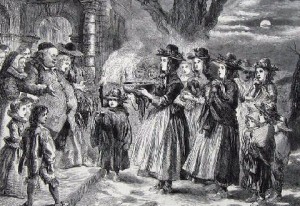 As traditional and familiar as most any English Christmas carol, the song is among the season’s more misunderstood. A celebration of a holiday custom that pretty much puzzles modern celebrants: wassailing.
As traditional and familiar as most any English Christmas carol, the song is among the season’s more misunderstood. A celebration of a holiday custom that pretty much puzzles modern celebrants: wassailing.
Wassailing? What’s wassailing?
The text of the carol employs noun and verb forms of “wassail.” A word derived from the Old Norse ves heil and Old English was hál meaning “be in good health”. The phrase found first use as a simple greeting. However Danish-speaking inhabitants of England turned was hail, and the reply drink hail, into a drinking formula..
Wassail also denoted the drink used for the toast. Spiced wine resembled the ancient Roman hypocras, which survived into the early Middle Ages as a libation for the wealthy. The necessity of importing the wine and such spices as ginger, cinnamon, cloves, allspice, and nutmeg made it dear. When fine ales replaced the wine, more people could afford it, and recipes varied according to the means of each family. Though usually prepared for immediate consumption, wassail sometimes was bottled and allowed to ferment.
The term has evolved in English for more than a millennium. What began as a simple greeting, became a toast in ritualized drinking. Now absorbed into holiday customs rooted in notions of social propriety.
The Wassail Bowl
The first mention of a wassail bowl was in the thirteenth century. A vessel in which revelers dipped cakes and fine bread. The practice of floating crisps of bread in the wassail bowl gave rise to our use of “toast” as a drinking salutation.
- “Toasts”
- Christmas parties
- Christmas bonuses
- Punch bowls (Think eggnog)
From Wassailing Through History
So lift your cups and join me now is I say was hál to this strange and wonderful old English tradition. And you thought wassailing was just a fancy name for caroling.

Another music history lesson, well told!
Thanks, Brad!
Wassup title…..best one so far!